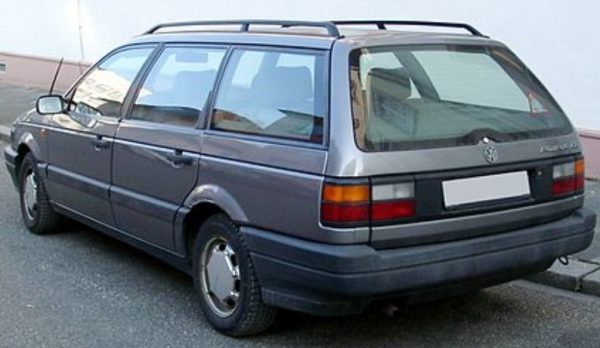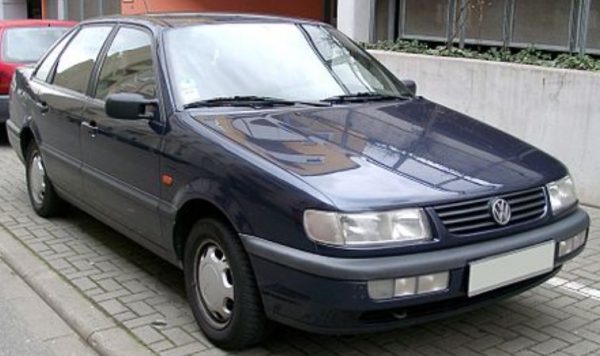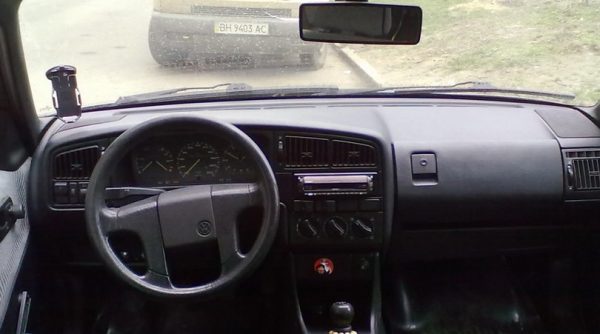
Overview of the Volkswagen Passat lineup
Content
Volkswagen Passat can rightfully be considered the most popular car of the German concern. For decades, the car has been successfully sold all over the world, and the demand for it is only growing. But how did the creation of this masterpiece of engineering begin? How has he changed over time? Let's try to figure it out.
A Brief History of the Volkswagen Passat
The first Volkswagen Passat rolled off the assembly line in 1973. At first, they wanted to give the car a simple numerical designation - 511. But then it was decided to choose a proper name. This is how the Passat was born. This is a tropical wind that has a significant impact on the climate of the entire planet. The drive of the first car was front, and the engine was gasoline. Its volume varied from 1.3 to 1.6 liters. The next generations of cars were assigned index B. To date, eight generations of the Volkswagen Passat have been released. Let's take a closer look at some of them.
Volkswagen Passat B3
In Europe, Volkswagen Passat B3 cars began to be sold in 1988. And in 1990, the car reached the United States and South America. The first B3 that rolled off the assembly line of the German concern was a four-door sedan of a very unpretentious appearance, and this unpretentiousness extended to the interior trim, which was plastic.

A little later, leather and leatherette trims appeared (but these were mainly expensive GLX models intended for export to the USA). The main problem of the first B3 was the small distance between the rear and front seats. If it was still comfortable for a person of average build to sit in the back, then a tall person was already resting his knees on the back of the front seat. So it was impossible to call the rear seats comfortable, especially on long trips.
Package B3
Volkswagen Passat B3 came out in the following trim levels:
- CL - the equipment was considered basic, without options;
- GL - the package included bumpers and mirrors painted to match the body color, and the car interior was more comfortable, unlike the CL package;
- GT - sports equipment. Cars with disc brakes, injection engines, sports seats and plastic body kit;
- GLX is a special equipment for the USA. Leather interior, concave steering wheel, power seat belts, sunroof, cruise control system, knee bars.
Types of B3 bodies, their dimensions and weight
Two types of bodies were installed on the Volkswagen Passat B3:
- sedan, the dimensions of which were 4574/1439/1193 mm, and the weight reached 495 kg;
 Passat B3, body variant - sedan
Passat B3, body variant - sedan - station wagon. Its dimensions are 4568/1447/1193 mm. Body weight 520 kg.
 Passat B3 station wagon was slightly longer than the sedan
Passat B3 station wagon was slightly longer than the sedan
The volume of the tank for both the sedan and the station wagon was 70 liters.
Engines, transmission and wheelbase V3
The Volkswagen Passat B3 generation was equipped with both diesel and gasoline engines:
- the volume of gasoline engines varied from 1.6 to 2.8 liters. Fuel consumption - 10-12 liters per 100 kilometers;
- the volume of diesel engines varied from 1.6 to 1.9 liters. Fuel consumption is 9-11 liters per 100 kilometers.
The gearbox installed on cars of this generation could be either an automatic four-speed or a five-speed manual. The wheelbase of the car was 2624 mm, rear track width - 1423 mm, front track width - 1478 mm. The ground clearance of the car was 110 mm.
Volkswagen Passat B4
The release of the Volkswagen Passat B4 was launched in 1993. The designation of the complete sets of this car remained the same as that of its predecessor. In essence, the Volkswagen Passat B4 was the result of a slight restyling of third-generation cars. The power frame of the body and the glazing scheme remained the same, but the body panels were already different. The interior design has also changed in the direction of greater comfort for both the driver and passengers. B4 was slightly longer than its predecessor. The increase in body length allowed German engineers to solve the problem of too closely spaced seats, which was mentioned above. On the B4, the distance between the front and rear seats has increased by 130 mm, which makes life for tall passengers in the rear seats much more comfortable.
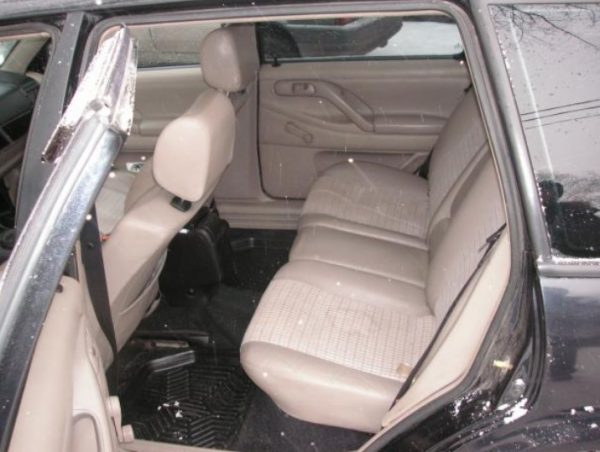
The interior trim has also changed slightly: in cheap trim levels it was still the same plastic, but now it was not black, but beige. This simple trick created the illusion of a more spacious cabin. In total, 680000 cars rolled off the assembly line. And in 1996, the production of the Volkswagen Passat B4 was discontinued.
Types of B4 bodies, their dimensions and weight
Like its predecessor, the Volkswagen Passat B4 had two body types:
- sedan with dimensions 4606/1722/1430 mm. Body weight - 490 kg;
 Passat B4 sedans were painted mostly black
Passat B4 sedans were painted mostly black - station wagon with dimensions 4597/1703/1444 mm. Body weight - 510 kg.
 Passat B4 station wagon had a fairly roomy trunk
Passat B4 station wagon had a fairly roomy trunk
The volume of the tank, like its predecessor, was 70 liters.
B4 engines, transmission and wheelbase
The engines on the Volkswagen Passat B4 have not changed much, except for the volume. If the predecessor had a maximum volume of a gasoline engine of 2.8 liters, then engines with a volume of 4 liters began to be installed on the B2.9. This slightly increased fuel consumption - up to 13 liters per 100 kilometers. As for diesel engines, their volume on all B4 was 1.9 liters. Less powerful diesel engines were not installed on the B4. The gearbox on the B4 has not undergone any changes. As before, it was produced in a five-speed manual version, and a four-speed automatic. The wheelbase on the Volkswagen Passat B4 reached 2625 mm. The width of both the front and rear track remained unchanged. The ground clearance of the car was 112 mm.
Volkswagen Passat B5
In 1996, the first Volkswagen Passat B5 was released. The main difference of this car was its unification with cars Audi A4 and A6. This procedure made it possible to install Audi engines on the Volkswagen Passat B5, which were more powerful and had a longitudinal arrangement. Serious changes have also taken place in the cabin of the B5. In short, it has become much more spacious.
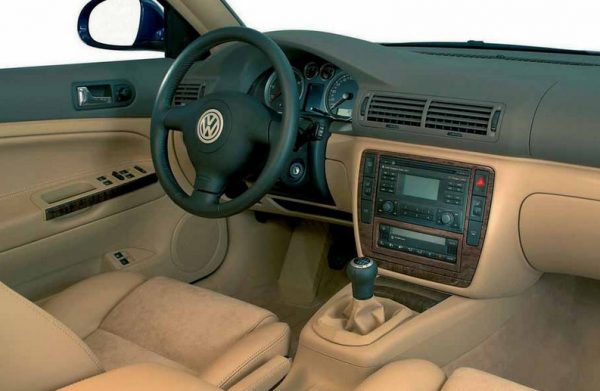
The rear seats have been pushed back another 100mm. The distance between the front seats has increased by 90 mm. Now even the largest passenger could easily fit on any of the seats. The interior trim has also changed: the engineers finally decided to move away from their favorite plastic, and partially replaced it with matter (even in the cheapest trim levels). As for export cars in GLX trim levels, their interiors were now trimmed exclusively with leather. Leatherette was completely abandoned there.
Body B5, its dimensions and weight
The body type of the Volkswagen Passat B5 is a sedan with dimensions of 4675/1459/1200 mm. Body weight 900 kg. The tank volume of the car is 65 liters.
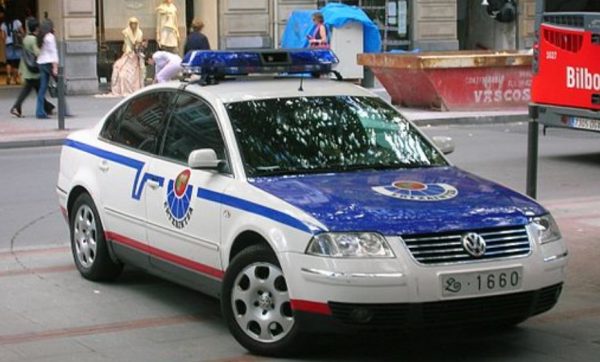
B5 engines, transmission and wheelbase
Volkswagen Passat B5 was equipped with petrol and diesel engines:
- the volume of gasoline engines varied from 1.6 to 4 liters, fuel consumption ranged from 11 to 14 liters per 100 kilometers;
- the volume of diesel engines varied from 1.2 to 2.5 liters, fuel consumption - from 10 to 13 liters per 100 kilometers.
Three transmissions were developed for the B5 generation: a five- and six-speed manual and a five-speed automatic.
The wheelbase of the car was 2704 mm, the front track width was 1497 mm, the rear track width was 1503 mm. Vehicle ground clearance 115 mm.
Volkswagen Passat B6
The general public first saw the Volkswagen Passat B6 in early 2005. It happened at the Geneva Motor Show. In the summer of the same year, the first European sales of the car began. The appearance of the car has changed dramatically. The car began to seem lower and elongated. At the same time, the dimensions of the B6 cabin practically did not differ from the dimensions of the B5 cabin. However, changes in the interior of the B6 are visible to the naked eye. First of all, this applies to the seats.
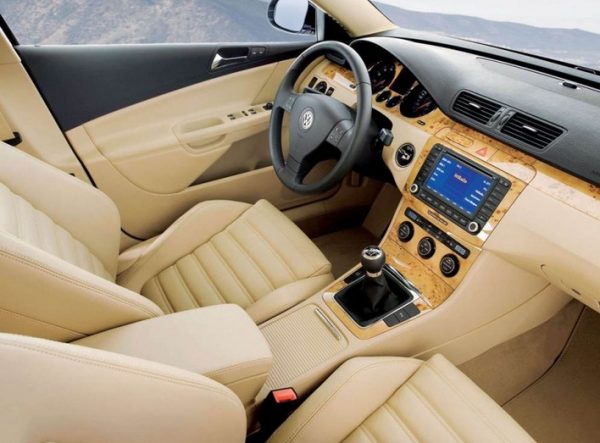
Their shape has changed, they have become deeper and better match the shape of the driver's body. The headrests have also changed: they have become larger, and now they can be tilted at any angle. The devices on the B6 panel were located more compactly, and the panel itself could be equipped with plastic inserts painted to match the car body color.
Body B6, its dimensions and weight
Volkswagen Passat B6 at the time of the start of sales was produced only in the form of a sedan with dimensions of 4766/1821/1473 mm. Body weight - 930 kg, fuel tank volume - 70 liters.

B6 engines, transmission and wheelbase
Like all predecessors, the Volkswagen Passat B6 was equipped with two types of engines:
- gasoline engines with a volume of 1.4 to 2.3 liters with a fuel consumption of 12 to 16 liters per 100 kilometers;
- diesel engines with a volume of 1.6 to 2 liters with a fuel consumption of 11 to 15 liters per 100 kilometers.
The transmission could be either a manual six-speed or an automatic six-speed. The wheelbase was 2708 mm, the rear track width was 1151 mm, the front track width was 1553 mm, and the ground clearance was 166 mm.
Volkswagen Passat B7
The Volkswagen Passat B7 is a restyling product of the B6. Both the appearance of the car and the interior trim have changed. The volume of engines installed on the Volkswagen Passat B7 has also increased. In B7, German engineers for the first time in the history of the series decided to deviate from their rules, and used a variety of materials in different colors in the interior trim.

The car doors were completed with white plastic inserts. White leatherette was on the seats (even in the cheapest trim levels). Instruments on the panel have become even more compact, and the dashboard itself has become much smaller. Engineers have not forgotten about safe driving: now the driver has an airbag. Finally, it is impossible not to note the regular audio system. According to most motorists, it was the best of all installed by the manufacturer on the Passat. The first car of this series left the assembly line in 2010, and in 2015 the car was officially discontinued.
Types of B7 bodies, their dimensions and weight
As before, the Volkswagen Passat B7 was produced in two versions:
- sedan with dimensions 4770/1472/1443 mm. Body weight - 690 kg;
 Sedan Passat B7 is a restyling product of the previous model
Sedan Passat B7 is a restyling product of the previous model - station wagon with dimensions 4771/1516/1473 mm. Body weight - 700 kg.
 The luggage compartment of the B6 station wagon has become even more impressive
The luggage compartment of the B6 station wagon has become even more impressive
Fuel tank capacity - 70 liters.
B7 engines, transmission and wheelbase
The Volkswagen Passat B7 was equipped with gasoline engines ranging from 1.4 to 2 liters. Each engine was equipped with a turbocharging system. Fuel consumption ranged from 13 to 16 liters per 100 kilometers. The volume of diesel engines ranged from 1.2 to 2 liters. Fuel consumption - from 12 to 15 liters per 100 kilometers. The transmission on the Volkswagen Passat B7 could be either a six-speed manual or a seven-speed automatic. Wheelbase - 2713 mm. Front track width - 1553 mm, rear track width - 1550 mm. Vehicle ground clearance 168 mm.
Volkswagen Passat B8 (2017)
The release of the Volkswagen Passat B8 was launched in 2015 and is currently ongoing. At the moment, the car is the most modern representative of the series. Its main difference from its predecessors lies in the MQB platform on which it is built. The abbreviation MQB stands for Modularer Querbaukasten, which means "Modular Transverse Matrix" in German. The main advantage of the platform is that it allows you to quickly change the wheelbase of the car, the width of both the front and rear tracks. In addition, the conveyor that produces machines on the MQB platform can easily be adapted to the production of machines of other classes. In the B8, engineers put the safety of both the driver and passengers at the forefront. Airbags were installed not only in front of the driver and passengers, but also in the car doors. And in the B8 there is a special automatic parking system that is able to park the car without the help of a driver. Another system while driving controls the distance between cars and the viewing area both in front of the car and behind it. As for the interior trim of the B8, unlike its predecessor, it has again become monophonic and white plastic again prevails in it.

Body B8, its dimensions and weight
Volkswagen Passat B8 is a sedan with dimensions of 4776/1832/1600 mm. Body weight 700 kg, fuel tank capacity 66 liters.
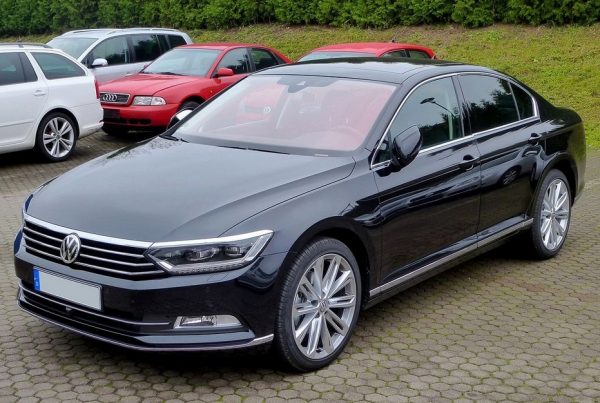
B8 engines, transmission and wheelbase
Volkswagen Passat B8 can be equipped with ten engines. Among them are both gasoline and diesel. Their power varies from 125 to 290 hp. With. The volume of engines varies from 1.4 to 2 liters. It should also be noted here that for the first time in the history of the B8 series, it can be equipped with an engine running on methane.
In addition, a special hybrid engine has been developed for the B8, consisting of a 1.4-liter gasoline engine and a 92 kW electric motor. The total power of this hybrid is 210 hp. With. Fuel consumption for cars of the B8 series varies from 6 to 10 liters per 100 kilometers.
Volkswagen Passat B8 is equipped with the latest seven-speed DSG automatic transmission. Wheelbase - 2791 mm. Front track width 1585 mm, rear track width 1569 mm. Clearance - 146 mm.
Video: Passat B8 test drive
So, Volkswagen engineers do not waste time. Each generation of Passat cars brings something new to the series, which is why the popularity of these cars is only growing every year. This is largely due to the well-thought-out pricing policy of the concern: due to the abundance of trim levels, every motorist will be able to choose a car for his wallet.



